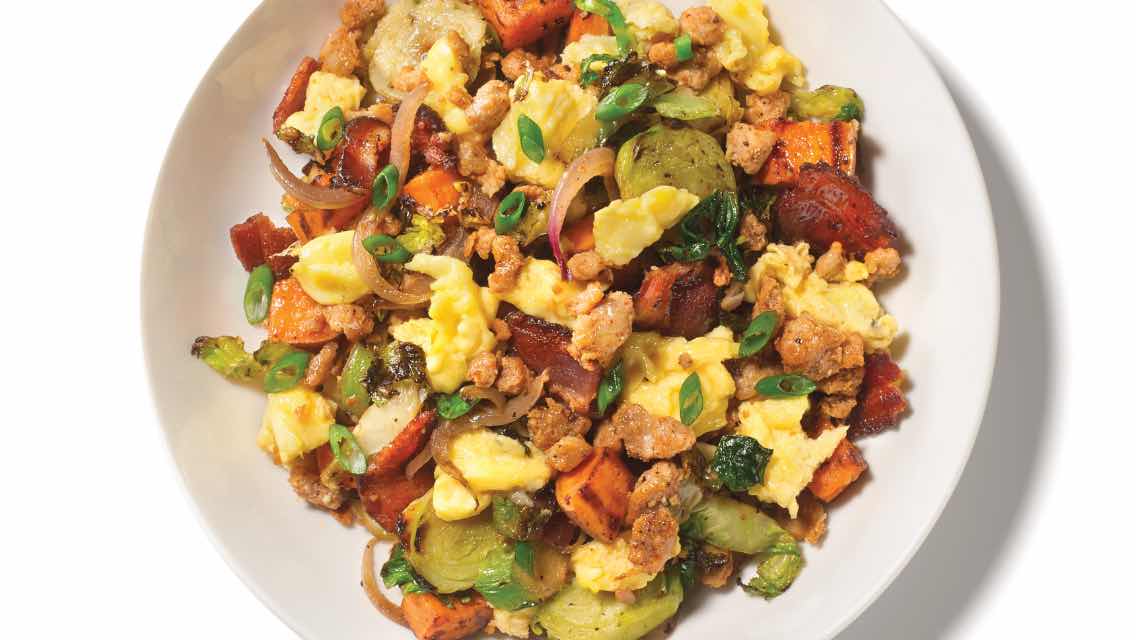One of my biggest learnings from working in the fitness and nutrition industry for more than a decade is that we’ve made healthy eating feel way more complicated than it needs to be. While specialized nutrition strategies can be helpful, they have a time and a place. And if we’re not careful, oftentimes we might be putting the cart before the horse.
From keto to vegan to intermittent fasting to “something”-free diets, well-meaning health experts spend a lot of time pouring over science and debating which nutrition approaches are best — all while confusing the very people they are trying to help.
Luckily, the foundations of healthy eating are simple, and are universal for most everyone. It’s the place we’d recommend anyone start before even considering other more targeted approaches. And often, simply forming a good base can help you see significant improvements to your health and the way you feel.
Now, that doesn’t mean they’re necessarily easy, especially if the habits are new to you. But if you focus on one aspect or step at a time, the changes will feel more approachable and eventually lead you to a healthier way of eating.
If you’re looking for a few ways to upgrade your diet and need somewhere realistic to start, try beginning with these five areas:
1. Eat protein with every meal.
From my experience, boosting protein intake as a first step usually serves as a great kick-start and motivator for clients, as it often helps them feel better in a short period of time. There are innumerable benefits of a higher protein diet, including that it can support your body composition, exercise recovery, and blood-sugar control (which in turn can stabilize your energy levels and dampen cravings).
Most people in the United States are hitting the Recommended Daily Allowance (RDA) of 0.8 grams of protein per kilogram of body weight (or 0.36 grams of protein per pound of body weight), which would be about 64 grams of protein for a 175-pound adult. However, the RDA is based on the amount of protein needed to support basic physiology and prevent deficiency symptoms — not what’s necessary to optimize health, vitality, and functioning.
Mounting evidence suggests that optimal intakes might be edging closer to one gram of protein per pound of body weight. That’s close to three times higher than the RDA.
While many of us tend to include a decent amount of protein at dinner, I’ve noticed that most people could benefit from including quite a bit more in their breakfast, lunch, and snacks. Even if you’re not ready to count or track exact numbers, you can still aim to make a few easy changes to boost your protein.
Here are some examples of how you could increase your protein at those times of the day, with the richest protein sources and amounts in bold:
| Instead of This | Try This | |
|---|---|---|
| Breakfast | Peanut butter toast | Peanut butter, banana, and vanilla whey smoothie |
| English muffin and an egg breakfast | 3-egg veggie omelet | |
| Lunch | Two tacos | Chicken & steak burrito bowl |
| Sandwich with two slices of turkey and cheese | Chef salad with 3 oz. turkey, cheese, and chopped hard-boiled eggs | |
| Snacks | Raspberry fruited yogurt | Plain full-fat Greek yogurt topped with raspberries |
| Pack of cheese crackers | 1-2 oz. sliced cheese and olives |
2. Aim to fill half of your plate with colorful vegetables.
“Eat your vegetables” might sound like boring and tired advice (who doesn’t know that’s good for you?). However, knowing and doing are two very different things.
There’s no doubt that a diet high in produce helps protect us from chronic disease and is supportive of a healthy lifestyle. The more color and variety you include, the better — we often say aim for the rainbow — as the colors represent phytonutrients that work together to provide metabolic benefits.
The vitamins, minerals, and fiber abundant in vegetables also support our energy levels, detoxification, antioxidant status, and more. Plus, they’re filling for relatively few calories (in contrast to most processed foods), so loading up can make calorie control feel more effortless.
Aim to eventually get to the point where at least half of your plate at every meal is comprised of vegetables, with as much as possible coming from non-starchy options. Non-starchy vegetables include ones such as leafy greens, cucumbers, asparagus, broccoli, onion, cauliflower, cabbage, peppers, celery, summer squash, Brussels sprouts, and mushrooms. (Starchier vegetables include options such as potatoes, corn, peas, root vegetables, and winter squash.)
If this has you picturing a plate full of plain, steamed broccoli or a snack of celery sticks, remember: Vegetables do not have to be boring.
Try skewering bell peppers, zucchini, and mushrooms as kebobs to grill and serve alongside your planned entree. Or pair a typical “meat-and-potatoes” dinner with garlic-roasted asparagus or roasted Brussels sprouts with bacon. Instead of a small side salad, try making it the main show, and add chopped basil, tomato, and red onion to serve alongside your protein of choice.
Start with vegetables you already know you like and aim to incorporate them more often and in bigger portions. Then, get creative: Mix it up with cooked and raw varieties, and experiment with new-to-you veggies and different preparation methods.
3. Be mindful of your carbohydrate amounts, and choose fiber- and nutrient-rich sources.
The average Western diet includes far too many refined starches that are devoid of vitamins and minerals. And we’re often basing our meals around the starch itself, such as French toast for breakfast, a plate of white rice under some chicken and veggies for a lunchtime stir-fry, or a bowl of angel hair pasta with meat sauce at dinner.
Consider this: Starch is just another name for complex carbohydrates, which are broken down into sugar. Too many carbohydrates can rob us of steady energy levels, cause blood-sugar roller coasters that make us feel hungry, and contribute to excess fat storage.
It’s not that carbohydrates are inherently bad — they aren’t! In fact, some people swing too far to the other end of the spectrum and begin fearing them all together, which can come with its own host of issues.
Start first by addressing the amount of carbohydrates you’re eating. If you aim to satisfy your hunger with carbohydrates, you’re more likely to overdo it, as they’re far less filling and nutrient-dense than protein and non-starchy vegetables. Aim to not only increase your overall portions of veggies and quality proteins, but try building your meals starting with them, too. Then, enjoy the carbohydrates you love as a side. By doing so, you’ll likely see a natural reduction in your refined carbohydrate intake because you’ll genuinely feel fuller.
You probably don’t need to eat less food by volume — most of us just need to eat slightly differently.
The next step would be to make upgrades to your source of carbohydrates, opting for whole-food options versus refined ones whenever possible. The closer the carbohydrate is to its natural form, the more likely it is to contain fiber and extra nutrients.
Refined carbohydrates include foods such as cereal, English muffins, toast, bread, pasta, hamburger buns, tortillas, chips, crackers, muffins, pita, naan, pancakes, cakes, cookies, brownies, and dinner rolls. Consider where you’d be willing to swap these types of foods out for higher-fiber, nutrient-dense options such as beans, lentils, root vegetables, minimally processed grains (such as quinoa or rice), or fruit (especially fiber-rich berries).
Could you try putting chickpeas or quinoa in your salad as a carb instead of eating the bread wedge it’s served with? Or could you consider having a roasted sweet potato with dinner instead of a side of orzo pasta? Would fresh summer berries topped with a bit of cream satisfy you as a stand-in for sorbet in the evening?
Even small changes in the amount and source of carbohydrates in your usual plan can make a big difference.
4. Add good, healthy fats for flavor.
Healthy eating should not be plain or devoid of flavor. By adding in healthy fats it not only makes meals more satisfying and satiating, but it can also help to bring out more flavor.
Inclusion of fat at meals can help certain vitamins — such as vitamins A, D, E, and K — be better absorbed. And for any fat skeptics out there, numerous studies in recent years have shown that, with the exception of trans fats (often found in ingredients lists as hydrogenated oil), the inclusion of fat does not contribute to heart disease or other health problems as once thought.
Naturally-occurring fat sources such as olive oil, avocado, olives, nuts, seeds, and coconut are ideal. Aim to avoid or limit as much as possible more processed versions of fat, such as corn, soybean, and canola oils, which are typically found in packaged foods such as potato and tortilla chips, baked goods, and bottled salad dressings.
Try using a homemade olive oil-based dressing on your salads — it’s great when whisked with herbs and either lemon juice or balsamic vinegar. Or try topping your taco bowl with a few slices of avocado. If you roast Brussels sprouts, mix in a sprinkle of pumpkin seeds before serving for a bit of crunch. Or add more flavor and satisfaction to a chocolate protein shake with a bit of unsweetened shredded coconut or sunflower seed butter.
5. Consider additional supplemental support.
You’ll frequently hear us say: “There’s no supplement that can replace a good diet. And there’s no diet so good that it couldn’t benefit from the right supplements.”
I know many people are leery of supplements, however, I’ve seen firsthand how they can help a client along their healthy way of life journey. Altering your nutrition habits takes time, and implementing a strategic, quality supplement regime can serve as an easy and quick win while you continue to work on other important changes.
Instead of adding in random supplements, botanicals, and extracts of questionable quality with false promises to secure your health, first consider ones that fill in nutrient gaps. Your metabolism relies on certain nutrients to function well, and optimizing your intake with supplements to support your baseline nutrition status is a more solid approach.
For most everyone, we recommend supplementing with five core supplements, which we refer to as the Foundational Five:
- High-quality multivitamin: Aim for capsule-based forms and think of them as a vitamin and mineral insurance policy, providing baseline levels of key nutrients.
- Omega-3 fish oil: Choose one that’s well-sourced and designed to support levels of health-promoting fatty acids, such as EPA and DHA.
- Vitamin D: Ideally select an active cholecalciferol form (vitamin D3) that’s paired with vitamin K2.
- Magnesium: This relaxing mineral is involved in more than 300 metabolic processes and is lost through stress and exercise. It’s best in a chelate form, such as di-magnesium-malate.
- Digestive enzymes: This supplement is taken at mealtime to support an optimal breakdown of food and nutrients.
If you’re brand-new to supplements and a whole core regime seems overwhelming, consider starting with just the first two. And as always, make sure to check with your physician first.
Bonus: Think additions instead of subtractions.
These nutrition upgrades are designed to be additive to your plan, not create feelings of restriction or deprivation: Boost your protein and veggie intake, bring in fiber-rich carb sources, increase flavor with healthy fats, and restore with quality supplements.
The more you focus on what to do, the more those choices edge out the things we don’t want to do. It’s a great way to make positive changes to your nutrition while still maintaining balance — free of guilt, shame, or rigidity.
Getting to an optimal place with your health and maintaining it for the long run is the result of consistently making positive choices. That doesn’t mean you need to be perfect, but you’ll progress if you make a concerted effort to improve your food choices, taking it just one meal at a time. Repeat enough of those healthy choices and you might soon surprise yourself with your whole new way of eating.





